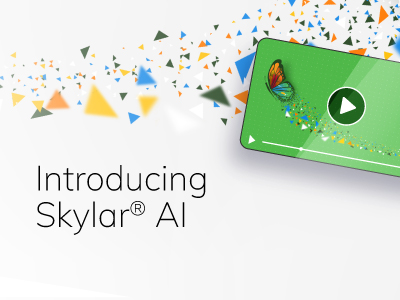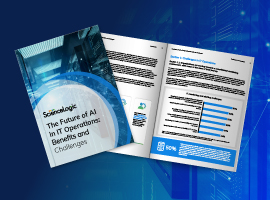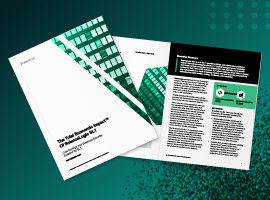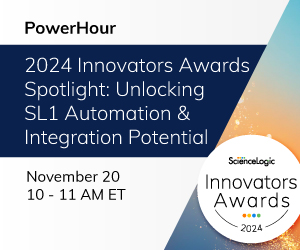- Why ScienceLogic
- Main Menu
- Why ScienceLogic
Why ScienceLogic
See why our AI Platform fuels innovation for top-tier organizations.
- Why ScienceLogic
- Customer Enablement
- Trust Center
- Technology Partners
- Pricing
- Contact Us
- Product Tours
 See ScienceLogic in actionTake a Tour
See ScienceLogic in actionTake a TourExperience the platform and use cases first-hand.
- Platform
- Main Menu
- Platform
Platform
Simplified. Modular-based. Efficient. AI-Enabled.
- Platform Modules
- Core Technologies
- Platform Overview
- Virtual Experience
 Skylar AI RoadmapRegister Today
Skylar AI RoadmapRegister TodayLearn about our game-changing AI innovations! Join this virtual experience with our CEO, Dave Link and our Chief Product Officer, Mike Nappi.
November 26
- Solutions
- Main Menu
- Solutions
Solutions
From automating workflows to reducing MTTR, there's a solution for your use case.
- By Industry
- By Use Case
- By Initiative
- Explore All Solutions
- Survey Results
 The Future of AI in IT OperationsGet the Results
The Future of AI in IT OperationsGet the ResultsWhat’s holding organizations back from implementing automation and AI in their IT operations?
- Learn
- Main Menu
- Learn
Learn
Catalyze and automate essential operations throughout the organization with these insights.
- Blog
- Community
- Resources
- Events
- Podcasts
- Platform Tours
- Customer Success Stories
- Training & Certification
- Explore All Resources
- 157% Return on Investment
 Forrester TEI ReportRead the Report
Forrester TEI ReportRead the ReportForrester examined four enterprises running large, complex IT estates to see the results of an investment in ScienceLogic’s SL1 AIOps platform.
- Company
- Main Menu
- Company
Company
We’re on a mission to make your IT team’s lives easier and your customers happier.
- About Us
- Careers
- Newsroom
- Leadership
- Contact Us
- Virtual Event
 2024 Innovators Awards SpotlightRegister Now
2024 Innovators Awards SpotlightRegister NowSave your seat for our upcoming PowerHour session on November 20th.
The Future of AIOps: Top 10 Predictions for 2024

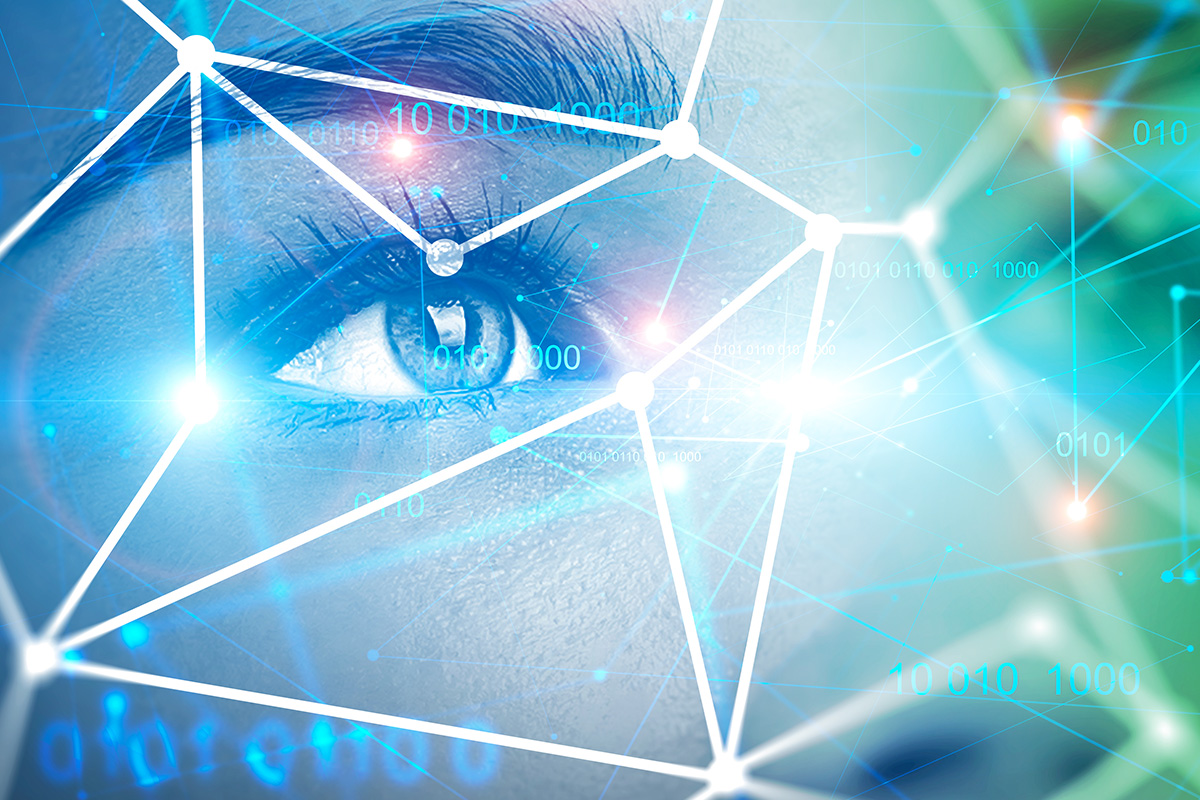
In the current competitive landscape, organizations are constantly pressured to increase efficiency, flexibility, and scale in response to market demands. Artificial Intelligence for IT operations (AIOps) is emerging as a pivotal technology to help companies meet these imperatives and secure a competitive edge. The increasing complexity of IT infrastructures, the need to manage the surge in data volumes, and the proliferation of decentralized devices, coupled with the unrelenting pursuit of operational efficiency to increase customer and employee satisfaction, are converging. This convergence positions AIOps not merely as another IT technology but as an indispensable component for a sustained digital transformation.
Below are the key macro trends propelling AIOps into strategic significance, underscoring its enduring impact on organizations’ business outcomes.
1. Market Consolidation – AIOps, Observability, Cybersecurity
As the conclusion of the current economic downturn cycle nears, the pace of consolidation is set to quicken, with major corporations and private equity conglomerates acquiring vendors in the Observability, AIOps, Security Information, and Event Management space. The product portfolio will undergo a phase of disentanglement while tool silos are integrated. Without this capability, companies won’t be able to ultimately empower ITOps, DevOps, and SecOps to jointly leverage integrated platforms that derive answers from corporate information faster and more holistically to accelerate the completion of strategic business outcomes.
2. Embracing the Complexity of Hybrid & Multi-Cloud Environments
Organizations are swiftly moving towards complex, multi-cloud, and hybrid IT environments because of the need to balance budgets with increasing cloud deployment costs fueling the need to bring back some of those deployments to the private cloud or even on-premises. In addition, the need to integrate diverse IT infrastructure from incoming acquisitions is topped by the procurement imperative to avoid vendor lock-in. This shift demands AIOps and observability solutions that provide comprehensive visibility and analytics across varied infrastructures as opposed to cloud-stack-specific ones, ensuring seamless operations regardless of complexity. Without this capability, organizations will face the challenge of dealing with disconnected silos, succumbing to public cloud vendor lock-in, incurring higher operational costs, and lacking full visibility across the IT estate.
3. Proactive and Easy to Consume Root Cause Analysis
A key driver for adopting AIOps is the reduction and elimination of downtime. AIOps platforms are being fine-tuned to better identify and address the root causes of IT issues. Expect AIOps vendors to leverage sophisticated AI and machine learning algorithms to analyze a more extensive array of information, ensuring quicker problem resolution and enhanced system reliability. Organizations must use use AIOps platforms that can utilize AI/ML to automatically extract valuable information from a large volume of logs, metrics, events, and other sources. This information should be summarized in natural language and delivered to users via smartphones, smartwatches, or computers.
4. The Rise of Predictive Analytics
Anticipating IT issues before they occur is the next frontier for AIOps. Integrating state-of-the-art predictive analytics will enable proactive management of IT environments, minimizing downtime and maximizing efficiency. Customers should be cautious when vendors claim to have AI predictive analytics, as many of them may only use fixed, linear modeling statistics. The best vendors will be those who can utlize the entire breadth and depth of data in the IT ecosystem, taking in account variance, noise, and seasonality. They will use AutoML and other neural network algorithms to generate a probabilistic forecast of an IT event before it occurs, such as an 85% likelihood of running out of storage next two days. This prediction could be extended to the business service, for example, there is an 87% chance that your e-commerce shopping cart will be out-of-service in the next 24 hours.
5. Mastering Real-time and Streaming Data
Handling large volumes of real-time, streaming, and telemetry data is set to become a staple in AIOps and observability strategies. This requires robust data processing capabilities and sophisticated analytics to keep up with the torrent of real-time information. However, don’t get too caught up in the need for independent ESP (Event Stream Processing) platforms as only one-third of use cases will be used for ingesting, transforming, and storing streaming data for AIOps and other analytical applications vs two-thirds to support real-time operational ones. Most AIOps platforms will extend their event processing capabilities to account for more real-time streaming scenarios.
6. Autonomous Remediation and Self-healing Systems
AIOps systems are on the cusp of a revolutionary shift towards autonomous remediation. By automatically resolving issues and proactively adjusting to prevent potential problems across DevSecOps. Cybersecurity will undoubtedly lead the way as the stakes are high. However, automated remediation will significantly help reduce the overall need for reliance on manual intervention across the board. Remediation and self-healing capabilities will guarantee that strict SLAs will remain in check for businesses to continue to operate despite fluctuations in utilization of their IT assets, and that cybersecurity vulnerabilities will be prevented or otherwise short-lived and addressed before more damage could extend into the organization’s IT ecosystem.
7. Topology AI-driven Optimization Improves Contextualization and Correlation
AI is set to revolutionize the way IT infrastructures are understood and managed by providing a richer and deeper picture of what’s going on, allowing IT departments to get more value out of the IT data they collect. Smartphones have become increasingly better with high-resolution cameras that use AI to detect people, animals, and objects in real-time. Thus helps the software enhance the photograph and create better pictures. Similarly, AIOps will leverage AI/ML to optimize or create dynamic topologies that leverage rich metadata from various sources such as configuration management, service discovery, cloud, virtualization, CMDB, APM, etc. Additionally, custom tags produced from user daily user and device interactions will be used in the process. AI will enhance correlation analysis and provide deeper insights, making IT management through correlation much more precise and insightful.
8. Generative AI Boosting Productivity and Democratizing Insight
Generative AI (GenAI) will increasingly play a pivotal role in augmenting productivity across IT operations. A new study by MIT experts found that GenAI can improve a worker’s performance by as much as 40%. GenAI’s capabilities can speed up the diagnoisis of root-cause analysis (RCA) and help create customized dashboards and reports. This will allow more people in the IT organization to benefit from it, including those who are closer to the business but have less technical skills. New employees will acquire institutional knowledge faster and ramp up quickly to have a higher impact. It will be transformational and a game-changer.
9. The Dawn of Conversational AIOps
The role of IT support desks is set to be revolutionized with the arrival of Conversational AI chatbots like Amelia. These chatbots will provide sophisticated answers and interact in natural language across several languages with users to solve their IT problems. This will be like having conversational ChatGPT bots with enriched language models with intrinsic real-time knowledge of the IT ecosystem. The conversational chatbots will leverage AIOps platforms to orchestrate user requests and automate remediation processes to tackle issues like security, compliance, and more. These AI-driven systems together, with AIOps platforms, will alleviate the need for L1/L2 technical support roles (redeploying them to other higher value-added areas in the organization) and allow operations to scale up and down in real-time.
10. Closer Cross-Functional Collaboration Around Information Security
In the evolving landscape of IT operations, the traditional boundaries between Information Technology Operations (ITOps), Development Operations (DevOps), and Security Operations (SecOps) are dissolving, giving rise to a more integrated and collaborative environment. This transformation is driven by the recognition that security considerations are no longer siloed within SecOps but have become a fundamental and pivotal element across all IT and development functions. As organizations increasingly embrace the interconnectedness of their operations, the need for a unified approach to information security has become more pronounced. In this collaborative paradigm, ITOps, DevOps, and SecOps professionals work together seamlessly, sharing insights, tools, and strategies to collectively address security challenges.
The Future of AIOps
The future of AIOps is poised to be a transformative force for IT operations, fundamentally reshaping how businesses interact with and manage their technological infrastructure. The convergence of AI with IT operations is not just a trend but a paradigm shift, offering unprecedented opportunities for organizations to enhance efficiency, predictability, and security in their IT environments.
These predictions reflect an IT landscape that is increasingly complex yet full of potential for those willing to embrace the next wave of technological evolution. From the consolidation of markets and the rise of predictive analytics to the advent of autonomous systems and the democratization of insights through GenAI. Each trend signifies a step towards a more integrated, intelligent, and proactive IT ecosystem that will help organizations rapidly adapt to business and market demands in increasingly efficient and creative ways.

